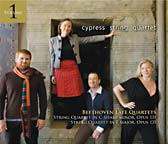This may be the start of something big
Audio Video Club of Atlanta
Phil's Classical Reviews
September, 2009

To audition and purchase visit cypressquartet.com
The San Francisco-based Cypress String Quartet, consisting of Cecily Ward and Tom Stone, violins; Ethan Filner, viola; and Jennifer Kloetzel, cello, have just released Volume 1 of a projected cycle of Beethoven's Late Quartets, and is it a beauty! I like the cohesion of these young artists, who have been playing as a group since 1996. Their mutual sympathy and blend are ideal, and they possess the virtuosity as individuals to meet the stern technical Beethoven poses here and still make the end result come across to the listener as the most exalted kind of musical fun – musicians at play!
Why start with the Late Quartets, when most foursomes usually begin with Opus 18 and work their up? It seems to be a matter of temperament and inclination with the Cypress Quartet, and something else besides. As Ward describes it, they began adding the Late Quartets to their repertoire in the first summer of their existence: "His music has nourished and strengthened our sensibilities ever since, in the years that we have explored and reveled in his music.... Beethoven has given us a context within which we could shape ourselves while exploring the emotional complexity of humanity." That business of shaping themselves includes a distinctive sound of the sort that is heard all too seldom since the prime of the late Quartetto Italiano. (Those who know my taste in quartet performance will realize how high a compliment that is!)
The Cypresses have wisely opted to release the Late Quartets in installments, rather than as a complete set. I say "wisely" because these quartets (Nos.12 thru 16 plus the Great Fugue) are an immense subject for study. It takes time and patience for both performers and home listeners to absorb them, but the rewards are great. In Volume 1 we are given the Quartets in C sharp Minor, Op. 131 and F Major, Op. 135. They make for an intriguing pairing, being the most avant-garde and the most perfectly "classical" of Beethoven's Late Quartets.
Op. 131 is a vast canvas covering no fewer than seven moments, played without breaks, and it has an enormous emotional range. The key signature of C-sharp Minor, unusual for a major string composition, allows Beethoven a rich tonal palette. It begins with a slow fugal movement based on the motto G sharp-B sharp-C sharp-A, in which the composer explores and develops every aspect of the theme. The second movement is based on a single theme, a wistful, lilting melody introduced by the first violin, The third movement, an 11-bar Moderato, serves as an intro to the fourth, an Andante consisting of a theme with six variations. This is the emotional heart of the work (at 14:27 it is longer than any two of the other movements), and the Cypress Quartet draw out all of its sublime possibilities. Interestingly, it has no fewer than seven expressive marking, including the very unusual Andante moderato e lusinghiero for Var. 3, where lusinghiero means "coaxing" or "flattering." These performers give the first half of this variation the pliancy it requires, making the contrast with the emphatic second half all the bolder. The last three movements are a brilliant Scherzo that takes the Cypresses from the depths to the heights of sublimity, ending with a sul ponticello (high on the bridge) passage for the entire quartet; a graceful Adagio in G sharp Minor; and a finale marked by its relentless drive and a subsidiary theme of striking beauty.
Op. 135, by contrast, marks a return to a more classical form. Haydn would have felt quite comfortable in this quartet (with the possible exception of an impassioned passage that briefly interrupts the genial, light-hearted finale). The shortest and most economically written of the Late Quartets, it is noticeably lighter in mood than Op. 131, written only a few months earlier. The most striking movement is the finale, featuring an exchange of three-note mottoes in F Minor and F major, which scan in German with the grim question Muss es sein? (Must it be?) and the triumphant answer Es muss sein In F Major (It must be!) Along the way, the Cypresses give us some really sensational pizzicati on a whimsical secondary theme, first introduced by the cello and then taken up by all hands.
In short, this is an auspicious start for the Cypress Quartet's Late Beethoven project. Keep your eyes (and ears) open for what this fine young foursome will be doing in the future.